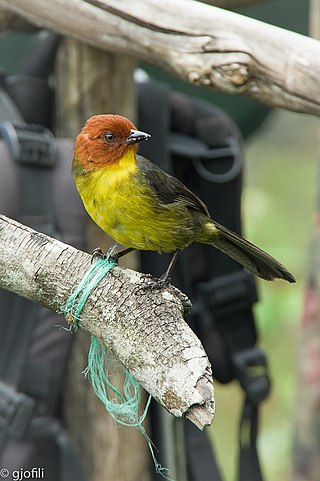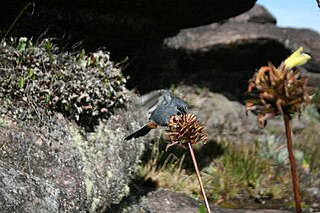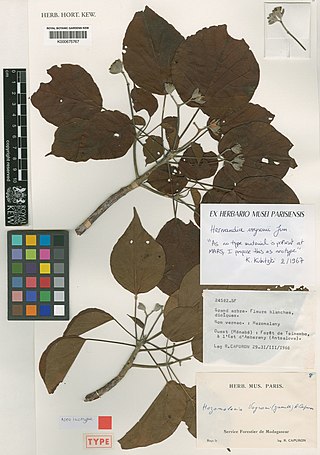La Gran Sabana is a region in southeastern Venezuela, part of the Guianan savanna ecoregion.

Anomaloglossus praderioi is a species of frog in the family Aromobatidae. It is found in the Pantepui region of southeastern Venezuela and western Guyana. More specifically, this frog is known from Mount Roraima, Sierra de Lema in Venezuela, and Maringma-tepui in Guyana. Its actual range is probably wider and might reach into northern Brazil.

The tepui parrotlet is a species of parrot in the family Psittacidae. It is found in the tepuis of northern Brazil, western Guyana, and southern Venezuela.

The tepui brushfinch is a species of bird in the family Passerellidae.

The greater flowerpiercer is a species of bird in the family Thraupidae. It is found in the tepuis of western Guyana, eastern Venezuela and far northern Brazil. Its natural habitats are subtropical or tropical moist montane forests and subtropical or tropical high-altitude shrubland.

The sierran elaenia is a species of bird in the family Tyrannidae.

The Roraiman antwren is an insectivorous bird in the antbird family, Thamnophilidae. It was first described by the Austrian ornithologist Carl Hellmayr in 1903 with the type locality of Mount Roraima (Venezuela).

The tepui vireo is a species of bird in the family Vireonidae.

Magnolia dealbata is a species of flowering plant in the family Magnoliaceae, native to Mexico. It is known commonly as the cloudforest magnolia and eloxochitl. It is sometimes considered to be a subspecies of Magnolia macrophylla, which is otherwise native to the southeastern United States.

The tepui toucanet or Whitely's toucanet is a near-passerine bird in the toucan family Ramphastidae. It is found in Brazil, Guyana, Suriname, and Venezuela.

Magnolia sharpii is a tree species of Magnolia from Chiapas, Mexico. It grows in wet tropical habitats.

The Guianan moist forests (NT0125) is an ecoregion in the east of Venezuela, north of Brazil and the Guyanas. It is in the Amazon biome. The climate is hot and humid, with two rainy seasons each year. As of 1996 the tropical rainforest habitat was relatively intact, although there were mounting threats from illegal logging and gold mining.
Magnolia pugana, commonly known as almacasusco, is a species of Magnolia from northern Jalisco and southern Zacatecas states in western Mexico.
Drimys roraimensis is a broadleaf evergreen tree of family Winteraceae. it is native to the tepuis, flat-topped mountains in southern Venezuela and western Guyana.

Hernandia voyronii, commonly known as Hazomalany, is a species of plant in the Hernandiaceae family. It is endemic to Madagascar.
Magnolia krusei is a species of plant in the family Magnoliaceae. It is endemic to Mexico.
Magnolia tamaulipana is a species of plant in the family Magnoliaceae. It is endemic to northeastern Mexico.
Magnolia sororum is a species of flowering plant in the family Magnoliaceae. It is commonly known as vaco. It is native to the mountain forests of Costa Rica and western Panama, and may range into Nicaragua.
Magnolia rzedowskiana is a species of flowering plant in the family Magnoliaceae. It is native to the Sierra Madre Oriental of San Luis Potosí, Querétaro, and Hidalgo states in eastern Mexico.
Magnolia vovidesii is a species of flowering plant in the family Magnoliaceae. It is native to the Sierra Madre Oriental of Veracruz state in eastern Mexico.












